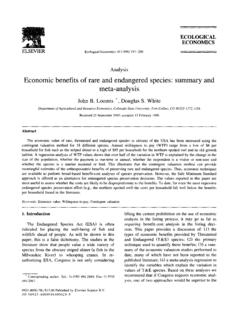Transcription of October 2016 The Economic Impact of Marijuana Legalization ...
1 October 2016 The Economic Impact of Marijuana Legalization in Colorado Prepared by Marijuana policy group Market Intelligence policy Design The authors would like to acknowledge useful comments, contributions, and suggestions by Mark Kleiman, Andrew Livingston, Dean Heizer, Christian Sederberg, Pat Oglesby, Steve Fox, Darren Karasiuk and Brian Lewandowski. All errors and omissions are the sole responsibility of the authors. Corresponding author: Adam Orens Authors Miles Light Adam Orens Jacob Rowberry Clinton W. Saloga Market Intelligence policy Design TABLE OF CONTENTS Marijuana policy group Synopsys .. 1 Section I. The Cannabis Industry in Colorado .. 2 Industry Structure .. 2 Integrating the Marijuana Industry into the Economy.
2 3 Section II. Industry Growth and Economic Impact .. 6 Industry Growth: Cause and Effect .. 6 Employment Effects .. 8 Tax Revenues .. 10 Section III. The Marijuana Impact Model Technical Description .. 13 Colorado-Specific Output and Employment Multipliers .. 13 Input-Output Table Construction .. 15 Calculation of Output and Employment Multipliers .. 15 Section IV. Economic Results in Context .. 18 Comparison of MPG Results with Other Recent Studies .. 18 Trends in Colorado s Cannabis Industry .. 20 SYNOPSIS Marijuana policy group Page 1 of 22 The Marijuana policy group (MPG) has constructed a new model that accurately integrates the legal Marijuana industry into Colorado s overall economy. It is called the Marijuana Impact Model.
3 Using this model, the MPG finds that legal Marijuana activities generated $ billion in state output, and created 18,005 new Full-Time-Equivalent (FTE) positions in 2015. Because the industry is wholly confined within Colorado, spending on Marijuana creates more output and employment per dollar spent than 90 percent of Colorado industries. Recent studies have attempted to capture impacts by using proxy data or invalid assumptions. Some of those studies are shown to generate grossly erroneous results. This study utilizes official data to overcome those mistakes and sets a clear record for future reference. Legal Marijuana demand is projected to grow by percent per year through 2020. This growth is driven by a demand shift away from the black market and by cannabis-specific visitor demand.
4 By 2020, the regulated market in Colorado will become saturated. Total sales value will peak near $ billion dollars, and state demand will be metric tons of flower equivalents by 2020. Market values are diminished somewhat by declining prices and low-cost, high-THC products. In 2015, Marijuana was the second largest excise revenue source, with $121 million in combined sales and excise tax revenues. Marijuana tax revenues were three times larger than alcohol, and 14 percent larger than casino revenues. The MPG projects Marijuana tax revenues will eclipse cigarette revenues by 2020, as cigarette sales continue to decline. Marijuana tax revenues will likely continue increasing as more consumer demand shifts into the taxed adult-use market.
5 As a first-mover in legal Marijuana , the Front Range has witnessed significant business formation and industry agglomeration in Marijuana technology (cultivation, sales, manufacturing, and testing). This has inspired a moniker for Colorado s Front Range as the Silicon Valley of Cannabis. Secondary Marijuana industry activities quantified for the first time in this report include: warehousing, cash-management, security, testing, legal services, and climate engineering for indoor cultivations. Caveats: The Impact of Marijuana Legalization upon tobacco and alcohol use is not included here. Similarly, issues such as public health, energy use, public education, enforcement costs, incarceration costs, or worker productivity are not considered in this assessment.
6 SECTION I. THE CANNABIS INDUSTRY IN COLORADO Marijuana policy group Page 2 of 22 With almost $1 billion in spending in 2015 ($996 million), the Marijuana industry clearly plays an Economic role in Colorado. Until now, it has been impossible to accurately characterize how this industry impacts the overall state economy. In order to estimate the state-level Economic effects of Legalization , the Marijuana policy group (MPG) has constructed the world s first Marijuana Economic Impact model. This new model can help voters, policymakers, and regulators understand how Marijuana Legalization impacts the state economy in terms of output, tax revenues, GDP, and employment. I-1. INDUSTRY STRUCTURE The MPG s Marijuana Impact model divides the industry into three segments: cultivation, manufacturing, and retailing.
7 Each segment is represented using a unique production function with differing inputs, outputs, and linkages to the economy. These segments are then integrated into Colorado s production and consumption structure, in order to reveal how Marijuana spending impacts the economy overall. State-level control of cannabis creates a highly-localized industry. Almost all spending on Marijuana flows to workers and businesses within the state. As a result, the Marijuana industry generates more local output and employment per dollar spent than almost any other Colorado sector. Only government program spending generates more employment and output per dollar spent. Figure 1 shows the relative Impact of Marijuana , in the context of other, more traditional industries in the state.
8 Figure 1. Economic Impact of Spending for Major Industries in Colorado Note: Impact result will be different in other states and regions. Applying the Marijuana Impact model to Colorado, it was found that each dollar spent on retail Marijuana generates $ in state output. This compares favorably with general retail trade, which yields $ per dollar. The more traditional (and sometimes subsidized) mining sector generates $ per dollar. General manufacturing generates $ per dollar, and casinos generate just $ per dollar of spending. Other industries have lower output yields because their inputs are sourced from outside of the state, or because the profits are remitted to corporate owners that exist primarily outside of the state as well.
9 SECTION I. THE CANNABIS INDUSTRY IN COLORADO Marijuana policy group Page 3 of 22 I-2. INTEGRATING THE Marijuana INDUSTRY INTO THE ECONOMY Industrial Classification: In order to integrate Marijuana activities into the overall economy, each segment of the industry is inserted into the state s Economic accounts. For example, the Marijuana cultivation sector is inserted between Floriculture Production and Tobacco Farming. Retail stores and dispensaries are inserted as a type of specialty retail store, and finally, infused product manufacturers are included as part of the food manufacturing sector. In this way, the production activities for each Marijuana segment can be connected with the rest of the Colorado economy. Business Spending Patterns: Next, the MPG constructed business spending patterns for each industry segment, in order to trace how Marijuana spending flows through the state s economy.
10 Since Marijuana is currently a cash- only business and is confined within the state, most of the cash accrues directly to local cultivation and manufacturing. Financial services are limited, and instead funds are spent on security and cash transportation services, such as armored vehicles. Figure 3 (following page) shows the approximate business spending patterns for each segment of the Marijuana industry in 2015. The largest spending category for retailers is the product itself ( Marijuana flower),1 followed by employee payrolls, business rent, security services, compliance, and consulting services. Cultivation in the Denver region is almost exclusively indoors, making electricity and HVAC the largest portion of spending, next to fertilizers, pesticides, and other agricultural inputs.









